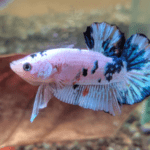Algae outbreaks plague most tanks eventually, even well-maintained setups. Strategically selecting efficient algae grazers transforms nuisance growths into nutritious biofilms supporting supplemental food chains benefiting entire aquarium ecosystems through balanced propagation kept check properly.
Herbivorous Plecos
Plecostomus suckermouth catfish varieties rightfully earned reputations combatting various algae forms using specialized adaptations targeting these feast sources underwater air breathers primarily consume.
Common Pleco
The ubiquitous pale brown common pleco seen stocking tanks small and large makes first considerations given impressive twelve inch lengths reached actively foraging widemouths continually graze surfaces scraping hearty meals aquarium glass offers continually renewing. Though requiring tremendous volumes eventually these workhorses battle multiple kinds from green spot forms and blanket algae equally effectively.
Bristlenose Pleco
Smaller yet no less eager selections like the bristlenose pleco thrive contained smaller setups reaching just five inches swimming through heavily planted spaces targeting brush, beard and green tuft algae their namesake bristly nose extensions efficiently manage keeping decorations and leafs cleared. Peaceful dispositions tolerate communities well.
Snail Solutions
Often overlooked snail species provide similar grazing benefits without issues larger plecos eventual size exceeds capacities average systems reasonably provide long term.
Nerite Snails
Tropical nerite snails feature gorgeous striped shell marking in varieties of zebra, red racer and sun thorn coloring while gobbling green spot algae tanks often struggle controlling. These 1 inch tidiers efficiently traverse all surfaces smoothing ecosystems balancing diatom and nuisance algae levels preventing dangerous population swings commonly occurring otherwise.
Ramshorn Snails
Prolific egg scattering ramshorn snails breed easily establishing earnest clean crews eliminating unsightly film and hair-like growths developing untended setups faster than most removal measures curtail when unleashed upon the buffet of aufwuchs meeting their smaller appetites. Vibrant red and blue ramshorns showcase attractive appearances too while performing duties.
Conclusion
Battling algae ultimately requires proper conditions preventing uncontrolled explosions harming delicate life supported underneath the photosynthetic layers desperately needing regulation restoring balance. Fortunately nature evolved perfect grazers up the task – whether armored plecos or regenerating snail swarms – that aquarists smartly recruit establishing control restricting sunlight exposure while administering clean crews bringing order thriving environments need.
FAQs About Algae Eating Aquarium Fish
1. What fish eat brown algae?
Common plecos, siamese algae eaters, American flagfish and surprisingly gouramis all graze brown diatom algae, soft film and beard growths establishing tanks successfully keeping subsequent propagation dye off when maintained.
2. Do White Cloud fish eat algae?
While not exclusively herbivores, nimble white clouds certainly supplement diets extensively grazing any algae, infusoria and microorganisms thriving surface their mountain stream environments. These make fabulous tank cleaners.
3. What is best snail for eating algae?
Spixi snails, nerites and ramshorn varieties all feature voracious appetites consuming copious green spot, hair, brush and black beard algae reliably. Just limit 1 inch sized specimens crawling over plants easily uprooted by heftier mature snail sizes.
4. Why is my algae eater not eating algae?
Ensure sufficient populations exist supporting grazer numbers introduced. Starvation triggers aggressive behaviors taking over if growth cannot sustainably support newcomers. Boost nutrients sparking blooms accommodating stocked consumption rates preventing aggression avoiding outcomes instead.
5. How do I get rid of algae without snails?
Manually remove accessible algae during routine glass cleanings. Use soft cloths gently wiping plant leaves weekly. UV clarifiers and chemical filtrants like polyfilters help control water column varieties. And reduce durations bright lighting remains activated minimizing photosynthesis opportunities algae requires propagating further.





